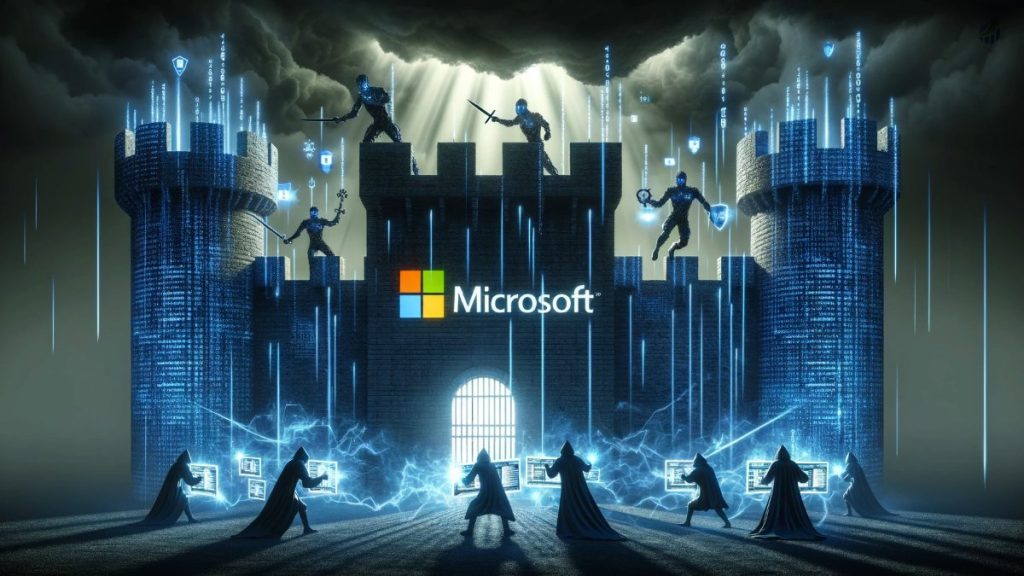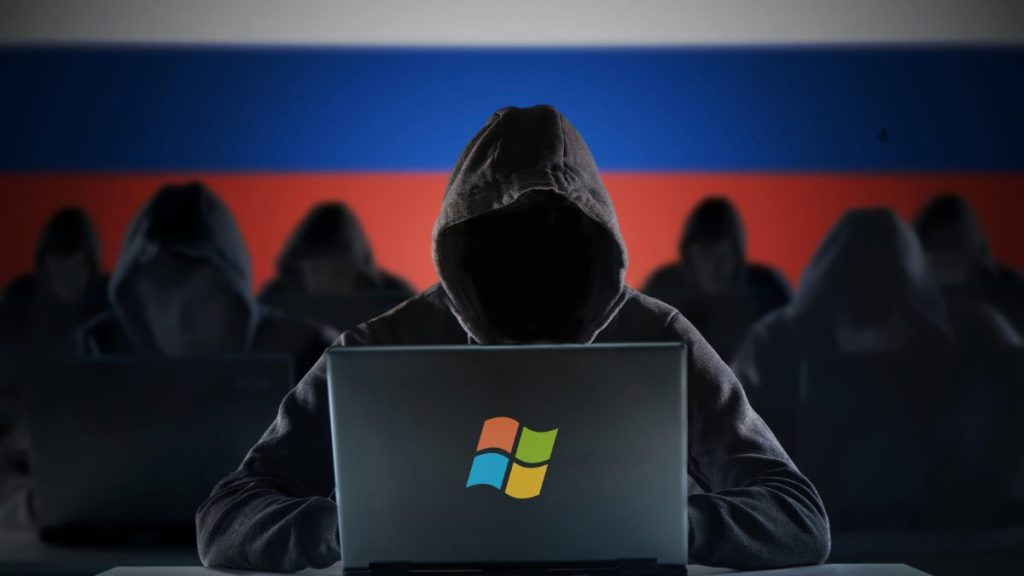In a series of sophisticated cyberattacks, Russian hackers, known by the names Nobelium and Midnight Blizzard, targeted Microsoft, showcasing the evolving threats posed by nation-state actors in cyberspace. These incidents underline the critical importance of cybersecurity vigilance and the ongoing battle between tech giants and state-sponsored cyber adversaries.
What Happened
In the shadowed corners of cyberspace, where digital espionage unfolds away from the public eye, a tale of intrigue and breach unfurled at the heart of one of the tech world’s giants, Microsoft. The protagonist of this narrative, a notorious Russian hacking group known by the chilling moniker ‘Midnight Blizzard’ executed a masterstroke of cyber intrusion that reverberated through the digital corridors of power.
Our story begins in the cold, wintry month of January, under the cloak of digital anonymity. Midnight Blizzard, employing a method as old as cyber warfare itself, launched a password spray attack. This seemingly rudimentary tactic belied the sophistication of its execution and the strategic choice of its target—a legacy non-production test tenant account within Microsoft’s vast digital empire. This account, left without the protective embrace of multi-factor authentication, became the Achilles’ heel through which the hackers infiltrated the sanctum.
The breach was not a brute force rampage but a calculated incursion. The compromised account, although a test tenant, had been endowed with elevated access rights, a vestige of its purpose within Microsoft’s corporate environment. It was through this doorway that Midnight Blizzard slithered in, gaining unprecedented access to the corporate email servers.
The treasure trove they found was not of gold or jewels but of data—corporate emails that contained the secrets of Microsoft’s leadership team, cybersecurity guardians, and legal defenders. Each mailbox plundered added to the hackers’ arsenal, providing them with authentication tokens, API keys, and credentials—a digital skeleton key fashioned from the very marrow of Microsoft’s defenses.
With these tools of espionage, Midnight Blizzard set their sights higher, targeting the very source code repositories that are the lifeblood of Microsoft’s technological prowess. This unauthorized access posed not just a threat of intellectual property theft but a potential chink in the armor for future exploits.
Upon discovery of this digital incursion, Microsoft was thrust into action, not merely to fortify their defenses but to warn those outside their walls whose secrets had been exposed in the stolen emails. The aftermath saw a surge in password spray attacks by Midnight Blizzard, prompting Microsoft to enhance their security measures and coordinate a response with law enforcement agencies.
This narrative is not merely a recounting of a cyberattack but a stark reminder of the ongoing digital warfare that rages unseen. It underscores the imperative for vigilance, the necessity of robust cybersecurity measures, and the ever-present threat posed by those who dwell in the shadows of the internet, waiting to strike. As Microsoft navigates these treacherous waters, bolstering their defenses and securing their digital domain, the tale of Midnight Blizzard serves as a cautionary epic in the annals of cyber espionage.
Nobelium: A Sophisticated Nation-State Attack
Nobelium, identified as a Russian state-sponsored hacking group, has etched its name into the annals of cybersecurity with what Microsoft deems one of the most sophisticated cyberattacks in history. This designation isn’t handed out lightly; it comes from Nobelium’s demonstrated proficiency in a wide array of cyber warfare tactics. The group’s arsenal includes advanced social engineering techniques, phishing expeditions, and the strategic deployment of malware. All meticulously designed to infiltrate networks undetected and pilfer sensitive data.
The hallmark of Nobelium’s approach lies in its stealth and precision. Unlike brute force attacks that leave a trail of digital destruction in their wake, Nobelium opts for a method that’s more akin to a whisper in the night. This modus operandi serves a clear purpose: to compromise the IT supply chain, thereby embedding themselves within the digital infrastructure of targeted entities. Once ensconced, Nobelium can conduct long-term surveillance and espionage, funnelling valuable intelligence back to the Russian government.
Perhaps the most notorious of Nobelium’s campaigns is the SolarWinds attack. This operation exemplifies the group’s interest in securing long-term access to critical points in the technology supply chain. By inserting malicious code into SolarWinds’ Orion software, an IT management tool used by tens of thousands of organizations, including U.S. government agencies, Nobelium could potentially spy on a vast array of targets without detection.
The implications of Nobelium’s actions extend far beyond the immediate fallout of any single attack. By targeting the supply chain, Nobelium seeks to undermine trust in the very foundations of our digital ecosystem. The SolarWinds breach, in particular, underscored the vulnerabilities that can arise from the interconnected nature of modern IT infrastructure, where a single compromised component can lead to widespread security breakdowns.
In response to these sophisticated threats, the cybersecurity community, led by entities like Microsoft, has been forced to adapt and evolve. The fight against groups like Nobelium has underscored the need for robust cybersecurity measures that go beyond traditional defenses. This includes enhanced scrutiny of software supply chains, the adoption of zero-trust principles, and the development of more sophisticated detection and response mechanisms.
Moreover, Nobelium’s activities have sparked a broader discussion on the nature of cyber warfare and the responsibilities of state actors in the digital age. As nations grapple with the realities of cyber espionage, the international community faces critical questions about norms, regulations, and the potential for collective defense mechanisms to protect against state-sponsored cyber threats.

Midnight Blizzard’s Breach
The cyberattack by Midnight Blizzard represents a stark reminder of the constant cyber threats that major corporations like Microsoft face, particularly from sophisticated actors linked to national governments. Starting with a password spray attack, a technique that attempts to access accounts using commonly used passwords, Midnight Blizzard targeted a non-production test account within Microsoft’s vast network. This initial foothold enabled the attackers to traverse through Microsoft’s systems, eventually gaining access to a select number of corporate email accounts. These accounts belonged to various high-level executives and employees across critical functions, including cybersecurity and legal departments.
Despite the breach’s apparent depth, Microsoft has provided assurances that the attack did not lead to any compromise of customer data or critical internal systems such as production environments, source code repositories, or artificial intelligence infrastructures. This distinction is crucial, highlighting that while the breach was significant, its impact was contained to a degree that prevented direct harm to Microsoft’s customers or the broader ecosystem relying on its services and technologies.
In response to the breach, Microsoft undertook a comprehensive review of its security posture and legacy systems. Recognizing the sophisticated nature of threats posed by groups like Midnight Blizzard, the company has committed to bolstering its defenses. This includes enhancing security protocols, reassessing and updating internal business processes, and implementing stricter controls over its legacy systems. Such measures are indicative of the evolving cybersecurity landscape, where organizations must remain vigilant and adaptive to counteract the strategies employed by advanced threat actors.
Furthermore, the incident underscores the broader implications for cybersecurity across the tech industry. As attackers continue to develop more intricate methods of infiltration, companies must prioritize the security of not just their own data and systems, but also protect against potential backdoors that could be exploited in supply chain attacks or similar strategies. The proactive steps taken by Microsoft in the wake of the Midnight Blizzard breach reflect a growing recognition of these challenges, emphasizing the need for continuous improvement in cybersecurity practices to safeguard against future threats.
Microsoft’s Response and Protective Measures
Microsoft has taken comprehensive steps to counter the threats posed by Nobelium and Midnight Blizzard. The company’s swift response to these attacks includes an extensive investigation, collaboration with law enforcement and cybersecurity partners, and the implementation of additional security measures to protect its own and its customers’ assets. Microsoft’s efforts also extend to improving the security of the broader ecosystem, particularly focusing on resellers and technology service providers that are integral to the IT supply chain. By sharing actionable intelligence and technical guidance, Microsoft aims to prevent these threat actors from achieving further success in their malicious campaigns.
These incidents highlight the persistent and evolving nature of cyber threats from nation-state actors. The attacks not only highlight the necessity of robust cybersecurity defenses but also the importance of industry-wide collaboration and transparency to combat such sophisticated adversaries.
Author Profile

- Lucy Walker covers finance, health and beauty since 2014. She has been writing for various online publications.
Latest entries
- June 30, 2025NewsWireBank Savings at Risk: The Dark Side of EU’s Savings Standard
- April 25, 2025Global EconomicsWhistleblowers Unmask Schwab’s Toxic WEF Secrets
- April 9, 2025Global EconomicsTariff Tensions Drive Market Volatility
- March 18, 2025Global EconomicsRed in Name Only: Labour’s War on the UK Working Class




